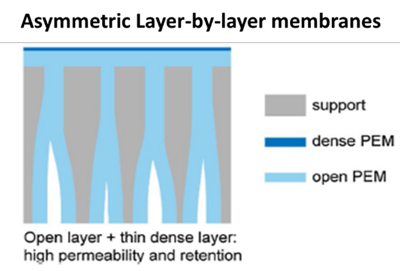Wendy Jonkers (PhD Candidate), Wiebe de Vos (promotor), Erik Roesink (promotor), Joris de Grooth (co-promotor and supervisor) |
Duration: 2020-2024 |
Funding: NWO-TTW 17744 |
This project is closely linked to the project of Hans David Wendt.
Introduction
The presence of so-called organic micro-pollutants (OMPs) in our surface water leads to growing awareness and concern. OMPs are very small organic molecules, stemming from medicinal or industrial origin that have the potential to cause long-term harm to humans and the environment. Municipal wastewater treatment plants are considered a hotspot for the release of OMPs into the environment as most OMPs end up in our wastewater, while our wastewater treatment plants were never designed for their removal. Techniques to remove these OMPs from the wastewater effluent are available, but are too costly, energy-intensive and unsustainable. Together with academia, knowledge institutes and industry, we develop an affordable and sustainable technology to remove OMPs from wastewater effluents. A novel nanofiltration membrane will be developed that discharges very clean effluent, while an OMP concentrate is further degraded in a conventional bioreactor
Key words
Nanofiltration, organic micropollutant, wastewater, surface modification
Technological challenges
Membranes which have a high retention for micropollutants typically also have a high retention for salts. Therefore, when OMPs are removed from waste water with nanofiltration membranes, a highly saline concentrate is created. This saline wastestream is difficult and expensive to treat. In order to circumvent this problem, we aim to develop a membrane with a high OMP retention and low salt retention
Research goals
Improving the asymmetric layer-by-layer membrane which was previously developed by our research group in order to develop a membrane with high flux, high OMP retention and low salt retentions.

Picture derived from: te Brinke, E., et al. (2020). "Asymmetric polyelectrolyte multilayer membranes with ultrathin separation layers for highly efficient micropollutant removal." Applied Materials Today 18: 100471. Doi.org/10.1016/j.apmt.2019.100471
This project also receives contributions from the following companies/institutions:
- KWR
- NX Filtration
- Nijhuis Water Technology BV
- Oasen
- Saxion
- Waterboard Rijn en IJssel
- Waterboard Vechtstromen
- Waterboard Aa en Maas
- Waterboard Vallei en Veluwe
- STOWA
